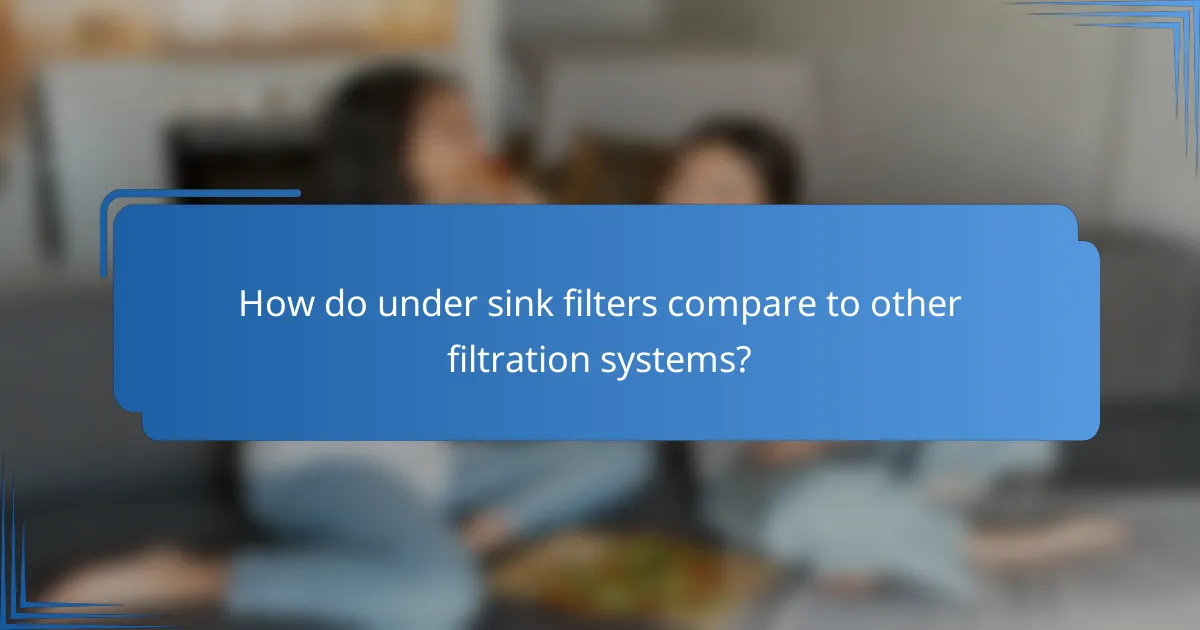Under sink filters offer a cost-effective solution for improving water quality in your home, with three main cost components: initial purchase price, installation expenses, and long-term maintenance costs. Installing these systems is straightforward, requiring minimal tools and time, while also conserving counter space. Additionally, budgeting for filter replacements is essential to maintain clean drinking water and manage ongoing expenses effectively.

What are the costs of under sink filters?
Under sink filters typically involve three main cost components: the initial purchase price, long-term maintenance costs, and installation expenses. Understanding these factors can help you budget effectively for clean drinking water in your home.
Initial purchase price
The initial purchase price of under sink filters can vary significantly based on the brand and filtration technology. Basic models may start around $50, while advanced systems with multiple filtration stages can range from $150 to $500 or more. Consider your water quality needs and the filter’s lifespan when choosing a model.
Long-term maintenance costs
Long-term maintenance costs primarily include filter replacements and any necessary repairs. Most filters require replacement every 6 to 12 months, with replacement cartridges typically costing between $30 and $100 each. Regular maintenance ensures optimal performance and extends the life of the system.
Average installation expenses
Installation expenses for under sink filters can range from $100 to $300, depending on the complexity of the system and local labor rates. Some systems are designed for DIY installation, which can save money, while others may require professional help. Always check if installation is included in the purchase price to avoid unexpected costs.

How to install an under sink filter?
Installing an under sink filter involves connecting the filtration system to your existing plumbing, typically requiring minimal tools and time. This setup can significantly improve your water quality without taking up counter space.
Step-by-step installation guide
Start by turning off the water supply to prevent leaks during installation. Remove the existing faucet if necessary, and then install the filter’s mounting bracket under the sink. Connect the filter to the cold water line using the provided tubing, ensuring all connections are tight.
Next, attach the filter’s faucet to the sink or countertop, following the manufacturer’s instructions. Once everything is connected, turn the water supply back on and check for leaks. Finally, run water through the filter for a few minutes to flush out any carbon dust before use.
Tools required for installation
To install an under sink filter, you will typically need a few basic tools: a wrench, a screwdriver, and possibly a drill if you need to create a hole for the new faucet. Most filter kits come with the necessary fittings and tubing, but having adjustable pliers can help with tightening connections.
Ensure you have a towel handy to catch any water spills during the process. If your installation requires drilling, a drill bit suitable for your countertop material is essential. Always refer to the specific installation manual for any additional requirements unique to your filter model.

What is the filter replacement budget?
The filter replacement budget for an under sink filter system typically includes the cost of replacement filters and any associated installation expenses. Understanding these costs helps homeowners plan for ongoing maintenance and ensure clean water access.
Average filter replacement costs
The average cost of replacement filters for under sink systems generally ranges from $30 to $100 per filter, depending on the brand and type. Some high-end systems may require filters that cost more, while basic models can be found at lower prices.
It’s wise to consider bulk purchasing options or subscription services offered by manufacturers, which can reduce overall costs. Always check compatibility with your specific filter model to avoid unnecessary expenses.
Frequency of filter changes
Filter changes for under sink systems are usually recommended every 6 to 12 months, depending on water quality and usage. High sediment levels or heavy usage may necessitate more frequent changes to maintain optimal performance.
Monitoring water taste and flow rate can also indicate when a filter needs replacement. Keeping a calendar or setting reminders can help ensure timely changes and prevent potential issues with water quality.

Which brands offer the best under sink filters?
Several brands are recognized for providing high-quality under sink filters, focusing on effective filtration and user-friendly installation. Popular options include brands like APEC, iSpring, and Home Master, which are known for their reliability and performance.
Top-rated brands
APEC is often praised for its reverse osmosis systems that deliver clean, great-tasting water. Their filters typically have a long lifespan and are designed for easy replacement. iSpring offers a range of under sink filters that are well-reviewed for their affordability and efficiency, making them a popular choice for budget-conscious consumers.
Home Master stands out for its innovative design and advanced filtration technology, which effectively removes contaminants while retaining beneficial minerals. These brands consistently receive high ratings from users for their performance and durability.
Brand comparison
When comparing these brands, consider factors such as filtration technology, ease of installation, and maintenance costs. APEC’s systems may have a higher upfront cost but often provide long-term savings due to their efficient filtration and lower replacement frequency.
iSpring tends to be more budget-friendly, making it an attractive option for those looking for a cost-effective solution. However, its filters might need to be replaced more frequently, which can add to long-term costs. Home Master products often combine advanced features with user-friendly installation, appealing to those who prioritize convenience.

What are the benefits of under sink filters?
Under sink filters provide significant advantages, including enhanced water quality and a compact design that saves space. They are an effective solution for households seeking clean drinking water without sacrificing kitchen area.
Improved water quality
Under sink filters effectively remove contaminants such as chlorine, lead, and sediment, resulting in cleaner and better-tasting water. Many models use advanced filtration technologies like activated carbon or reverse osmosis to ensure high purification standards.
Regular maintenance and timely filter replacements are crucial for maintaining water quality. Depending on usage, filters may need replacement every 6 to 12 months, which is a manageable cost for most households.
Space-saving design
Under sink filters are designed to fit neatly beneath kitchen sinks, freeing up counter space for other uses. This compact installation makes them ideal for small kitchens or areas where space is at a premium.
Installation is typically straightforward, often requiring only basic plumbing skills. Many models come with all necessary components, making it easy for homeowners to set them up without professional assistance.

What are the common issues with under sink filters?
Under sink filters can experience several common issues that affect their performance and longevity. Understanding these problems can help users maintain their systems effectively and ensure clean drinking water.
Clogging problems
Clogging is a frequent issue with under sink filters, often caused by sediment buildup or the accumulation of contaminants. Regular maintenance, such as replacing filters according to the manufacturer’s recommendations, can help prevent this problem.
To minimize clogging, consider installing a pre-filter that captures larger particles before they reach the main filter. This can extend the life of your main filter and improve water flow.
Leakage concerns
Leakage can occur due to improper installation or wear and tear on seals and connections. Regularly checking for signs of leaks, such as water pooling under the sink, is crucial for preventing water damage and maintaining filter efficiency.
To address leakage, ensure all connections are tightened and inspect the hoses and fittings for any signs of deterioration. If leaks persist, replacing worn components may be necessary to restore proper function.

How do under sink filters compare to other filtration systems?
Under sink filters are often more efficient and cost-effective than other filtration systems, such as countertop filters or pitcher filters. They provide a permanent installation that delivers filtered water directly from the tap, reducing the need for frequent replacements and offering better filtration performance.
Under sink vs. countertop filters
Under sink filters are installed directly under the kitchen sink and connect to the existing plumbing, while countertop filters sit on the counter and require manual filling or attachment to the faucet. This difference in installation affects convenience and space usage, with under sink filters typically being more discreet and freeing up counter space.
In terms of filtration efficiency, under sink systems often utilize multiple stages of filtration, including carbon and reverse osmosis, which can remove a wider range of contaminants compared to many countertop options. For example, under sink filters can effectively reduce lead, chlorine, and other harmful substances, while countertop filters may only address basic impurities.
Cost-wise, under sink filters generally have a higher initial installation expense, ranging from low hundreds to a few hundred dollars, but they can save money over time through reduced filter replacement costs. Countertop filters, while cheaper upfront, may require more frequent filter changes, leading to higher long-term expenses.
